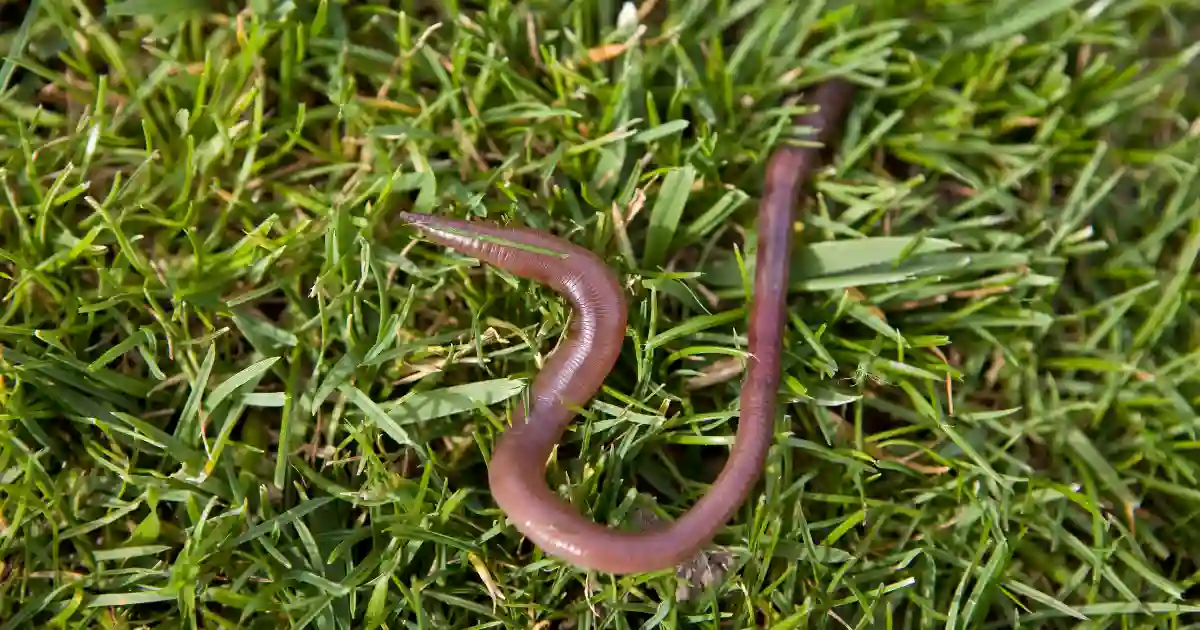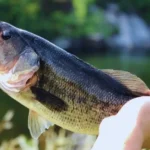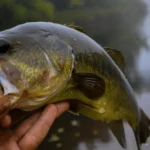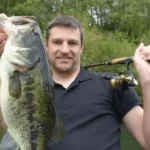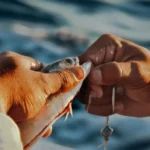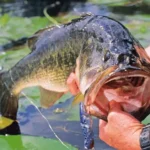Yes, you can fish with worms that have already died. Although live worms work better, dead worms can still get fish to bite, especially bottom-feeding fish like catfish and carp.
Can you fish with dead worms for bass? This is a debated technique among veteran bass anglers. While lively baits tend to draw reflex strikes, many swear that using dead worms can be effective, especially for trophy-sized bass.
But can you fish with dead worms for bass consistently? In this article, we’ll cover when and how dead worms can produce big bass when other baits fail. You’ll learn the best techniques for rigging and fishing deceased worms to tap into inactive lunkers.
We’ll also examine prime scenarios and conditions that make it a smart move for you to fish with dead worms for bass. If you think only lively baits catch bass, this may change your approach and put more big bass in your boat!

Why Fish with Worms
Worms make excellent bait for fishing for several reasons:
- Proven effectiveness: Fish instinctively react to wiggling worms, making them irresistible bait. Species from largemouth bass to bluegills actively feed on worms. Worms have likely caught more fish over the years than any other bait. The traditional combination of a worm dangling below a bobber has been passed down for generations.
- Easy to use: Hooking and rigging worms is simple enough for children to learn quickly. This makes worm fishing ideal for families. Even young kids can reel in sunfish and small bass independently with just a worm and bobber setup. Worms help build confidence in new anglers.
- Low cost: A tub of worms costs just a few dollars and can catch dozens of fish. It’s much cheaper than constantly replacing expensive lures that get snagged and lost. Especially for parents taking groups of children fishing, not having to stress about the investment makes worm fishing even more appealing. For anglers on a budget, worms provide great value.
What Fish Like Worms
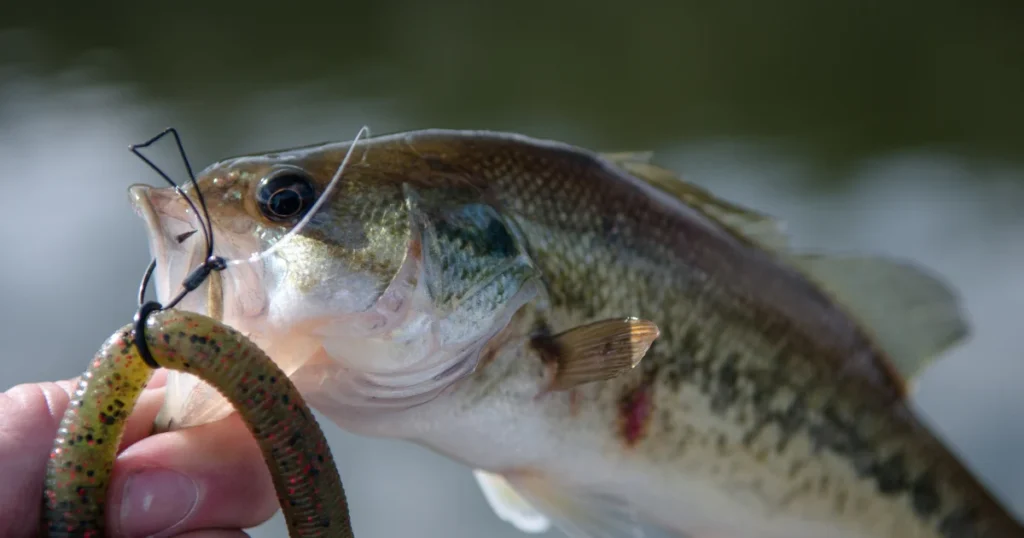
Worms appeal to a wide variety of fish in both freshwater and saltwater:
- Largemouth and smallmouth bass: From spawn to fall, bass of all sizes devour worms. Flipping worms into heavy shallow covers has become a significant technique in bass tournaments.
- Panfish: like bluegills, sunfish, and crappie – These aggressive biters swarm around worm pieces below bobbers or small jigs. Easy to catch and fun for kids.
- Catfish: of all species – Channel cats, blues, and flatheads scavenge along the bottom and take advantage of the scent trail worms leave.
- Trout: especially freshly stocked hatchery trout – Stocker’s key in on the wiggling motion and brightness of worms drifting by.
- Perch: walleye, pike, muskie – These predators rely more on eyesight but still strike worms. Especially effective during night fishing.
- Striped bass: redfish, snapper – Schooling saltwater species are used to eating live marine worms and hit them readily.
- Carp: Large grass carp gorge on vegetation but also use their sense of smell to vacuum up worms from the bottom.
Any fish that relies primarily on scent, taste, and vibration will be attracted to worms at some point. Sight feeders like peacock bass that focus on lures often ignore them. But when nothing else elicits strikes, worms can turn on finicky fish.
What Color Worms Do Bass Like?
Worms are a bass fishing staple. Their action in the water tempts the bass into striking. But what colour worms work best?
While there is not universally proven best colour, understanding how bass perceives colour and tying colour to conditions can help you select the best shades. Here are some top options to consider:
- Black: Excellent colour for dirty water or low light. It creates a bold silhouette that the bass can detect.
- Green Pumpkin: Imitates the natural green shades of baitfish. A versatile go-to in many water clarities.
- Watermelon: Has translucent, shad-mimicking effects. Productive colour across various water clarities.
- Junebug is a dark purple: blue flake that stands out in tinted water. Mimics bluish baitfish.
- Red Shad: Mimics the reddish hues of crayfish. Works well in more transparent water and around vegetation.
- White: Contrasts nicely in dirtier water. It is suitable for water or noisy rigs that attract via vibrations.
Why Fish Are Attracted to Worms
Worms have several key features that make them powerfully attractive bait for most fish species:
- Scent: The strong, fishy scent of worm mucus leaks into the water and attracts fish from a considerable distance away. Fish like catfish have an incredible sense of smell, able to detect tiny concentrations of appealing odor molecules. This allows them to hone in on the scent trail.
- Movement: The wiggling and vibration of a worm sends pressure waves that fish feel with their lateral line organ. This system covers their body and detects minute changes in water currents. The erratic worm movement pings their lateral line and alerts them to a potential meal.
- Texture: The soft, squishy worm feels natural when fish inhale and bite down. This triggers their predatory instinct to bite harder rather than spit it out. Plastic baits can’t replicate this fleshy feel.
- Visibility: The reddish translucent color of worms stands out underwater, making them easy for fish to spot. Contrast is critical, and they look very different from common forage like shad or crayfish. This unique appearance draws attention.
- Taste: The fatty tissue and salty flavor of worms register as a food source, causing fish to hang on longer while biting rather than instantly spitting it out.
Live vs. Dead Worms for Fishing
Generally, live worms will outfish dead worms in most situations when fishing:
- Durability: Live worms stay on hooks much better, with natural wriggling that keeps them threaded properly. Dead worms tend to fall off hooks more easily. You’ll go through bait faster with dead worms.
- Appeal: The movement and scent dispersion of a living worm is much more attractive to fish. The erratic motions and pulses of a live worm better mimic wounded prey.
- Effectiveness: The irresistible wiggle of a live worm triggers those instinctive predatory reflexes in fish to attack it. A dead worm soaked in attractant might produce, but never as well.
So why would anglers ever use dead worms? In some cases, convenience factors in:
- Pre-preserved: worms from bait shops stay longer in hot weather when live worms die quickly. Easier to keep on multi-day trips.
- Digging worms: can be difficult in drought conditions when worms burrow deep. Dead worms are still produced in lakes and ponds.
When fishing with kids, dead worms are less messy and give them something to do, like re-bait their hooks.
Overall, dead worms can still catch fish in certain situations when enhanced with bait spray attractants. Just be prepared for less frequent and more tentative bites than lively worms.
Why Worms Die
Worms are living creatures that require some care to stay alive and lively for fishing:
- Temperature: The ideal temperature range for worms is about 55-65°F. Much warmer or colder than this for extended periods causes worms to die off. This is why worms sold as bait are best kept refrigerated.
- Moisture: Drying out is deadly to worms. Their skin must remain damp to breathe, so keeping worms in moist newspaper, peat moss, or leaves is essential. Take care not to submerge them in standing water, though.
- Oxygen: Worms also require adequate oxygen. Adding air holes or opening the storage container replenishes O2 and prevents suffocation.
- Rough Handling: While worms are pretty hardy, gently handling them avoids damaging their soft bodies. Ripping them in half or puncturing them with hooks can cause injury and infection.
- Follow proper: to regulate temperature, moisture, and oxygen levels. This will keep your worms alive, healthy, and lively for catching many fish. Take the same conscientious care as you would for live shrimp or minnows.
Making Worms More Enticing
To make worms even more tempting to fish, try soaking them in scented attractant sprays. These formulas contain concentrated fish oils, amino acids, and other flavor enhancers designed to magnify a bait’s natural aroma.
Spraying down your worms before hooking them on infuses them with these potently appetizing scents. When released into the water, the additive makes the worms irresistible to predators. Just a few puffs can lead to savage strikes when the fish attack!
Additional Nightcrawler Considerations
Nightcrawlers are a topworm species used for bait. Here are some key points about using them:
- Do worms drown? No, worms can survive underwater for extended periods until their oxygen stores run out. During heavy rains, nightcrawlers will crawl to the surface to replenish oxygen levels in their blood. But they can handle being submerged while fishing.
- Night fishing: As the name suggests, nightcrawlers are most active once the sun goes down. Their peak feeding times are at night. That makes them perfect for targeting many fish species after dark since both are on the prowl.
- Saltwater: Some inshore saltwater fish will hit freshwater nightcrawlers, especially gamefish like redfish, snook, and trout that aren’t as discerning. Still, marine worms like sand fleas and bloodworms work better for most open-water species.
- Ice fishing: Bits of nightcrawler are a deadly bait for catching panfish like bluegills and crappie through the ice. The small pieces keep better than whole worms, which tend to freeze. Targeting the bottom with mini-worms is a proven ice tactic.
Getting and Keeping Worms
There are two main ways to acquire worms for fishing:
- Buy worms: at bait shops and stores for convenience. Shop for the best bulk prices on quality worms and stock up when they go on sale. Look for plump, lively worms that are undamaged.
- Catch your own: by digging in rich soil after rainstorms or pulling up small rocks, boards, and logs in damp areas. This can save money if you have a good worm source near home, only what you’ll use soon to keep them vigorous.
To keep worms overnight or longer for fishing:
- Proper storage: Keep worms refrigerated at 55-65°F in containers with ventilation. Damp peat moss, shredded paper, or leaves work well. Keep them out of direct contact with ice.
Care:
- Avoid extremes of heat or dryness, and don’t handle worms roughly.
- Gently return unused worms to the storage media.
- Maintain the moisture and coolness they require.
- Rinse: Use cool, clean water to rinse worms and remove debris/slime buildup before fishing with them.
Best Worm Fishing Techniques
Worms can be fished in many ways, offering versatility for anglers:
Plain Hook
For bluegills, thread the worm onto a small Aberdeen hook (#6-10). The thin wire allows worms to wiggle. A cast near structure-like docks and let the worm sink slowly, jigging occasionally.
Texas Rig
Bury hook into the head of the worm to make it weedless when fishing heavy cover for bass. The point hides. Drag worm over matted grass and lily pads to get down where big bass lurk.
Drop Shot
Balance worm nose-hooked on thin drop shot hook and vertically fish it along the structure. Hovering the worm above the bottom triggers light-biting largemouth and smallmouth bass.
Split Shot & Bobber
Add a small split shot and float worm 2-3 feet under fixed or slip bobber for panfish. Cast along weed lines and wait for the bobber to dart down as sunfish and crappie attack.
Jig Worm
Tip: 1/16 or 1/8 oz marabou or bucktail jigs with 2-3″ plastic worm tails. Swim or bounce jigs along the bottom, slowly reeling the curly tail. Deadly for walleye.
To Conclude: Can You Fish with Dead Worms for Bass?
As we’ve covered, can you fish with dead worms for bass? While this technique goes against conventional wisdom, dead worms can be a secret weapon for catching inactive lunker bass in certain situations. Use giant dead worms rigged weedlessly to tempt big bass unwilling to expend energy on lively baits.
Target warm weather, pressured fish, clear water, and pre-spawn bass to get the most out of this method. Now that you know how and when to effectively fish with dead worms for bass, be bold and try this overlooked technique when the conditions are right.
You may land that trophy fish you’ve been after! Remember, can you fish with dead worms for bass? If you use the right approach and techniques, the answer is a resounding yes.

